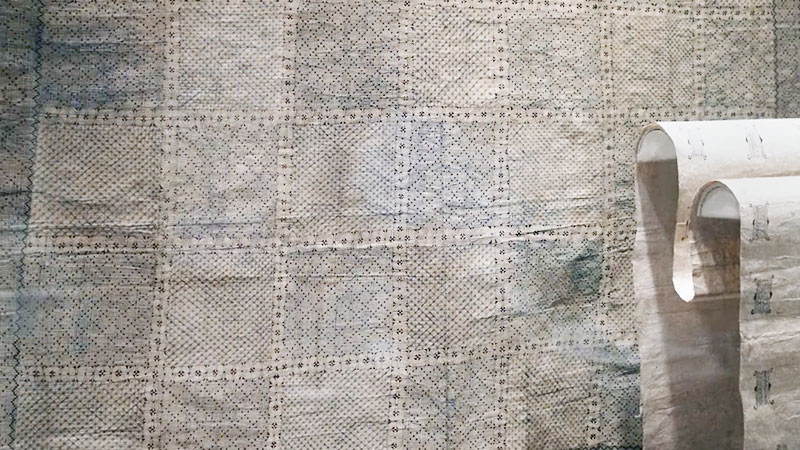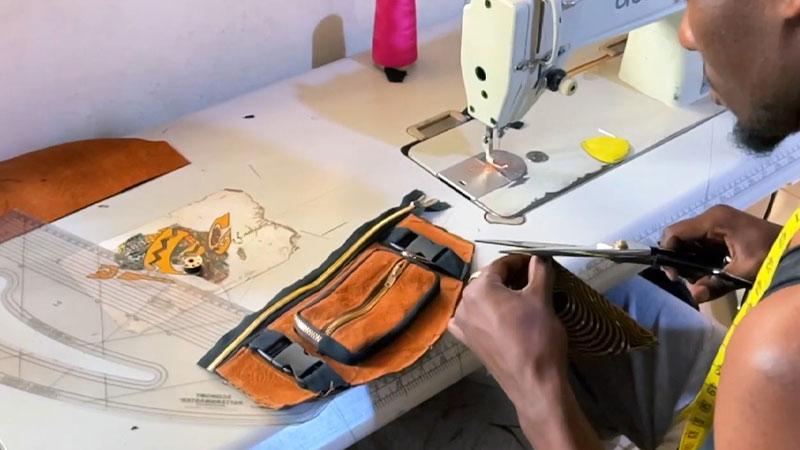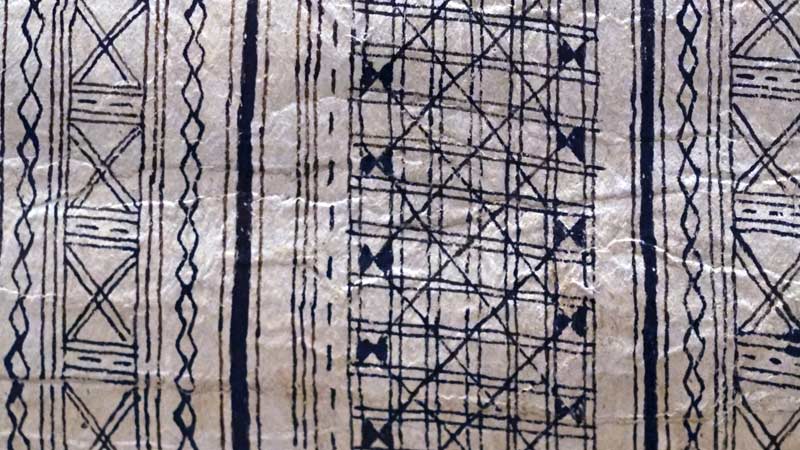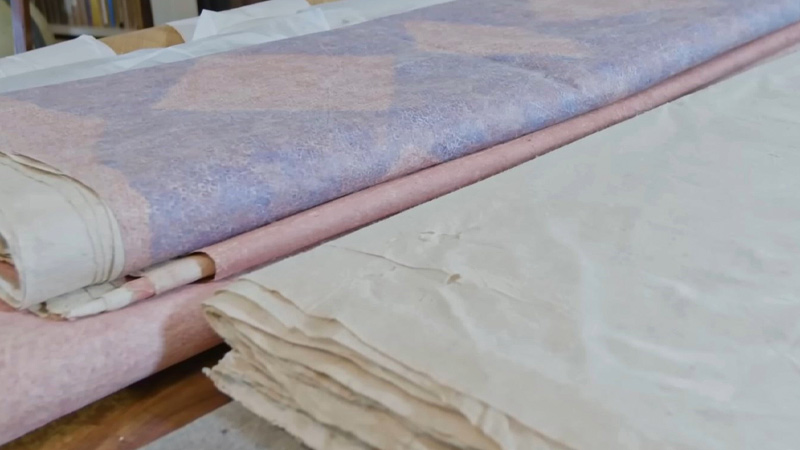Sewing with bark cloth, an age-old textile crafted from the inner bark of select trees presents a captivating fusion of tradition and practicality.
This unique fabric, cherished by indigenous cultures across the globe, carries with it a rich history of craftsmanship.
But what makes it truly intriguing is its inherent ease of sewing. Bark cloth’s natural pliability, minimal fraying, and forgiving nature make it an ideal choice for both novice and experienced sewers.
Beyond its ease of use, this sustainable and culturally significant material offers a canvas for creativity and personal expression.
In this exploration, we delve into the reasons why sewing bark cloth is not only a manageable endeavor but a rewarding one.

What Is Barkcloth?
Barkcloth is a versatile and culturally significant textile made from the inner bark of specific trees, most commonly the Ficus tree.
This ancient fabric-making tradition has been practiced for centuries by indigenous communities in various parts of the world, including Africa, the Pacific Islands, and parts of Asia.
The process involves harvesting the inner bark, soaking it, and then beating it until it becomes soft, pliable, and flat. The resulting material exhibits a unique texture, characterized by a slightly coarse surface with a smooth underside.
Barkcloth is renowned for its natural flexibility, durability, and resistance to fraying. It has a rich cultural heritage and is used for a wide range of purposes, including clothing, ceremonial items, home decor, and artistic expression.
Its sustainable and eco-friendly qualities make it an increasingly sought-after material in today’s world.
Is It Easy to Sew Bark Cloth?

Yes, it is so easy to sew bark cloth. Sewing bark cloth is an age-old practice that has been perfected over centuries by various indigenous cultures, particularly in regions like Africa, the Pacific Islands, and parts of Asia. This unique fabric, made from the inner bark of specific trees, offers several characteristics that make it relatively easy to sew.
Here are some reasons why it is easy to sew bark cloth:
Natural Flexibility
Bark cloth is renowned for its natural flexibility and pliability. The process of making bark cloth involves beating the inner bark of trees until it becomes soft and supple. This pliability makes it easier to manipulate and sew compared to other stiffer materials.
Minimal Fraying
Bark cloth is less prone to fraying compared to some woven fabrics. This is because the fibers are interlocked during the beating process, creating a cohesive surface that holds up well when stitched. This minimizes the need for extensive hemming or edge finishing.
Forgiving Nature
Bark cloth can be forgiving when it comes to minor mistakes or alterations. The fibers naturally conceal small punctures or needle holes, making it easier for novice sewers to work with. This forgiving quality is especially valuable for those learning to sew.
Absence of Synthetic Chemicals
Bark cloth is an entirely natural material, free from synthetic chemicals or additives commonly found in modern fabrics.
This lack of chemicals not only makes it safer for the environment but also reduces the risk of allergic reactions for those handling the fabric.
Sustainable and Renewable
The source of bark cloth, usually specific trees like the Ficus tree, is a sustainable and renewable resource.
This means that the material can be harvested without harming the environment or depleting precious resources. The sustainability of the source material is a compelling reason for choosing to sew with bark cloth.
Customizable and Decorative
Bark cloth readily accepts various embellishments and decorations, such as painting, dyeing, or embroidery.
This versatility allows for creative expression and personalization, making it an attractive choice for sewers who want to add unique designs to their projects.
Tradition and Cultural Significance
Sewing with bark cloth often carries cultural and historical significance. Many indigenous communities have passed down their knowledge and techniques for generations, resulting in a deep cultural connection to the material.
This heritage can inspire a sense of purpose and dedication when working with bark cloth.
How to Identify Barkcloth?

Identifying barkcloth, a unique and culturally significant textile, can be an interesting and informative endeavor. Barkcloth has distinct characteristics that set it apart from other fabrics.
Here’s how to identify barkcloth:
Texture and Appearance
Barkcloth boasts a tactile and visual texture that sets it apart. It features a slightly coarse surface with a smooth underside, akin to tree bark. When touched, it feels distinctively textured.
Thickness and Weight
Compared to many other fabrics, barkcloth is notably thicker and denser. It has a substantial weight and resists easy compression when pinched between your fingers.
Natural Fiber Composition
One of the key identifiers of barkcloth is its natural fiber composition. It is crafted from the inner bark of specific trees, like the Ficus tree, making it distinctly organic.
Lack of Synthetic Components
Unlike modern textiles, barkcloth is typically devoid of synthetic components like polyester or nylon, showcasing its natural and eco-friendly attributes.
Cultural or Geographical Context
Understanding the cultural or geographical context of where you come across barkcloth can offer valuable clues.
It has historical significance in indigenous cultures across Africa, the Pacific Islands, and parts of Asia.
Age and Preservation
Older barkcloth may show signs of aging, wear, or fading, contributing to its unique character. Conversely, a well-preserved barkcloth retains its vibrant colors, intricate designs, and structural integrity, emphasizing its cultural importance.
Acquisition Source
Purchasing barkcloths from reputable sources or dealers specializing in textiles or indigenous art can provide documentation and information to confirm their authenticity.
Consult Experts
When uncertainty arises or you’re dealing with valuable or historically significant pieces, consult experts, textile historians, or cultural institutions with expertise in barkcloth identification and authentication.
How to Make Bark Cloth?

Making bark cloth is a traditional and labor-intensive process that has been practiced by various indigenous cultures for centuries.
The following is a simplified overview of how is bark cloth is traditionally made:
Materials Needed:
- The inner bark of a specific tree (such as the Ficus tree)
- Mallet or beating tool
- Wooden board or anvil
- Water
Steps to Make Bark Cloth:
1. Bark Harvesting
This initial step requires great care and expertise. Indigenous artisans select specific trees, often Ficus trees, whose inner bark is suitable for making cloth. They then strip the bark, ensuring minimal harm to the tree.
This process is often conducted with a deep respect for the environment and the sustainable use of resources.
2. Bark Soaking
Once the bark is harvested, it is submerged in water for an extended period. This soaking process can range from several days to several weeks, depending on the thickness and desired characteristics of the bark cloth.
The extended soaking serves to soften the tough fibers and increase their pliability, making them easier to work with in subsequent steps.
3. Fiber Separation
After the soaking period, the dampened bark is removed from the water and placed on a flat surface, typically a wooden board or anvil.
This is where the skill and artistry of the artisan come into play. Using a mallet or beating tool, they gently pound the bark.
This action serves two critical purposes: it separates the individual fibers and flattens the bark, transforming it from a rough, fibrous material into a more cohesive and flexible cloth.
4. Continued Beating
The process of beating the bark continues, often for an extended period. The artisan must regularly turn the bark to ensure uniformity in thickness and texture.
Over time, the bark becomes progressively thinner and more flexible as the fibers further spread out and align.
5. Drying
Once the desired thickness and flexibility are achieved, the bark cloth is allowed to naturally dry in the sun.
This phase is essential for setting the fibers and solidifying the fabric’s characteristics. The sun’s warmth not only dries the cloth but also imparts a unique quality to the material.
6. Finishing
Post-drying, the bark cloth may undergo additional treatments to refine its texture or enhance its aesthetic appeal.
This might involve carefully scraping the surface to achieve a smoother texture, ensuring that the cloth is comfortable to touch and wear.
Additionally, indigenous artisans often use various artistic techniques to decorate the bark cloth, such as painting, dyeing, or incorporating intricate designs through stencils or block printing.
Uses of Bark Cloth

Bark cloth is a versatile and culturally significant material that has been used for various purposes by indigenous cultures around the world. Its unique properties and historical significance make it valuable for a wide range of applications.
Here are some common uses of bark cloth:
Clothing
One of the primary uses of bark cloth is for clothing. Indigenous communities have fashioned it into garments such as robes, skirts, loincloths, and ceremonial attire. Its natural flexibility and breathability make it comfortable to wear in different climates.
Ceremonial Attire
Bark cloth often plays a central role in traditional ceremonies and rituals. It is used to create clothing and accessories worn by individuals participating in cultural events, dances, and rites of passage.
Home Decor
Bark cloth is employed as a decorative element in homes. It can be used as wall hangings, curtains, and room dividers, adding a touch of natural elegance and cultural significance to living spaces.
Art and Craft
Many indigenous artisans use bark cloth as a canvas for their artistic expressions. They paint, dye, or decorate it with intricate designs, telling stories and preserving cultural narratives.
Bark cloth art is not only visually striking but also a means of passing down traditions to future generations.
Bedding and Mats
In some cultures, bark cloth is used to create bedding, mattresses, and mats. Its natural texture provides a comfortable surface for sleeping, and it can be easily rolled up and stored.
Sacred and Ritual Objects
Bark cloth is often used to wrap sacred objects or as an integral part of religious ceremonies. It may be used to cover idols, ritual drums, or other items of spiritual significance.
Carving and Sculpture
Bark cloth can be used as a base for carving and sculpting. Artisans create intricate sculptures and masks by applying bark cloth to wooden frames and then shaping and decorating it.
Baskets and Containers
In some cultures, bark cloth is used to make baskets and containers for storing food, tools, or other items. Its pliable nature makes it suitable for weaving into various shapes.
Currency and Trade
Historically, bark cloth has been used as a form of currency or trade in some regions. It was highly valued and exchanged for goods in local and intertribal trade networks.
Eco-Friendly Products
In contemporary times, there is a growing interest in eco-friendly and sustainable materials. Bark cloth is being explored for use in modern fashion and home decor, providing a unique and environmentally conscious alternative to synthetic materials.
Care Instructions for Bark Cloth
Caring for bark cloth, a unique and culturally significant textile, requires attention to its specific characteristics to ensure its longevity and continued beauty.
While bark cloth is known for its durability, it does have some unique care considerations.
Here are some care instructions for bark cloth:
Gentle Cleaning
Begin the care process by gently removing loose dirt and debris from the surface of the bark cloth.
Utilize a soft, clean cloth or a delicate brush, carefully brushing or shaking off any particulates. This preliminary step helps prevent abrasion during subsequent cleaning.
Spot Cleaning
Address localized stains or soiled areas with caution. Moisten a soft cloth or sponge with clean, lukewarm water, ensuring it is not overly saturated.
Blot the affected region gently, avoiding vigorous rubbing, which might compromise the integrity of the fabric or compromise any decorative elements.
Avoid Submerging in Water
Exercise utmost care to prevent submerging bark cloth in water. This practice can lead to excessive moisture absorption, weakening the fibers and potentially causing stretching or distortion. As such, avoid machine-washing or immersing the cloth in water for any extended duration.
Dry Cleaning
For more substantial stains or when the entire piece necessitates cleaning, consult professional dry cleaning services well-versed in handling delicate textiles like bark cloth. Prior to engaging their services, convey the distinctive characteristics of the material to ensure appropriate care.
Sunlight and Storage
Shield bark cloth from prolonged, direct exposure to sunlight. Prolonged sunlight exposure can result in the gradual fading of the fabric’s vibrant colors.
When not in use, store the bark cloth in a cool, dry environment, safeguarded from both direct sunlight and excess humidity.
Consider rolling the cloth and storing it within a breathable fabric or acid-free paper to protect it from dust and potential pests.
Repairs
Regularly inspect the bark cloth for loose threads or signs of damage. Should you detect any, enlist the expertise of a professional textile conservator or restorer with a specialized focus on bark cloth. Their skill and experience are invaluable in preserving the fabric’s integrity.
Artwork Preservation
In instances where bark cloth features decorative artwork or intricate designs, exercise additional caution.
Protect the painted or dyed surfaces from accidental damage or scratching. Refrain from any actions that might compromise the artwork’s integrity.
Display and Use
When using bark cloth as wall hangings or room dividers, ensure secure anchoring to prevent sagging or stretching over time.
Properly supported displays enhance the fabric’s longevity and aesthetic appeal.
Avoid Folding
Minimize prolonged periods of folding or creasing, as these actions may result in permanent creases that are challenging to rectify. Maintain the fabric as flat as possible during storage and display.
Consult Cultural Experts
In the case of exceptionally valuable or culturally significant bark cloth, consider consulting experts or cultural institutions.
They can offer guidance on suitable care practices and preservation methods that align with the fabric’s unique heritage.
FAQS
Is bark cloth suitable for machine sewing?
Bark cloth’s pliability makes it suitable for both hand and machine sewing.
Can I dye or paint bark cloth after sewing it into a garment?
Yes, you can dye or paint bark cloth even after it has been sewn into a garment.
Do I need special needles or thread for sewing bark cloth?
While not always necessary, using heavy-duty needles designed for sewing thicker fabrics can be beneficial when working with bark cloth. A sturdy thread, such as cotton or polyester, is generally suitable for sewing bark cloth.
Can I use bark cloth for quilting projects?
Yes, bark cloth can be used in quilting projects, adding a unique texture and cultural touch to your creations.
Is it possible to combine bark cloth with other fabrics in a single sewing project?
Yes, you can combine bark cloth with other fabrics to create unique and visually appealing designs.
To Recap
Sewing with bark cloth, a time-honored textile with deep cultural roots offers a fascinating journey that seamlessly blends tradition and practicality.
While the process may initially seem challenging, the inherent qualities of bark cloth, such as its natural flexibility, resistance to fraying, and forgiving nature, make it an accessible and rewarding choice for sewers of varying skill levels.
Its sustainable origins and versatile applications underscore its enduring appeal in a world increasingly valuing eco-conscious practices.
By embracing the art of sewing with bark cloth, artisans connect with age-old traditions, creating not just garments and crafts but also bridging the past with the present, where sustainability and cultural heritage converge harmoniously.
Leave a Reply